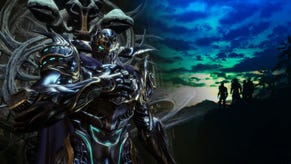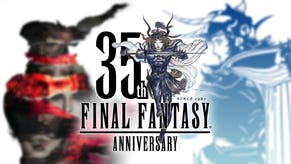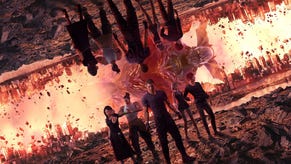Stranger of Paradise Final Fantasy Origin brings a little FF13 to its world - hands-on
After a surprise E3 announcement and a playable demo designed to garner fan feedback, we take a look at a new demo of the latest Final Fantasy spin-off, showcasing feedback-driven changes and new additions.
Last week, I got to play Stranger of Paradise: Final Fantasy Origin again, playing a new build that follows on from the publicly-released trial version from a couple of months ago. This new build of the game has a fair amount to offer, too. For one, it features many improvements and tweaks based directly on fan feedback from the first trial. Second, it dives a little deeper into many of the game’s features, in particular offering a deeper look at some of the available jobs including ‘advanced’ job classes. There’s also more story intrigue, a new party member, and other curious considerations.
Most curious of all, however, is the new area I got to explore in this new hands-onl. Called the Refrin Wetlands, it bears a striking resemblance to a zone from another Final Fantasy, and teases at the edges of what the nature of FF Origin’s story really is.
To get specific - this new zone is clearly at the very least inspired by the Sunleth Waterscape, an area from Final Fantasy 13. The memorable melody of Sunleth’s hummable theme tune weaves in and out of the area’s music - which is much more dark and foreboding than in FF13 - and that area’s unique mechanic makes a return.
For those who haven’t committed every wrinkle of the mainline Final Fantasy games to memory in an act of hyper-saddo nerdery, as I have, Sunleth Waterscape featured a mechanic where players could interact with mysterious orbs to change the weather, which in turn had a knock-on effect on your navigation of the area. The same is true for the Wetlands; it’s either dry or rainy, with orbs flipping you back and forth between the two. In FF Origin’s Refrin Wetlands, this opens up new pathways and is crucial to making your way through what is ultimately a pretty linear level, albeit one that twists and loops back on itself in various ways.
Making it rain will make tree roots stretch out, creating all-new paths while blocking off others. Halting the rain reverses that, of course - and getting through the area requires you to work through it piecemeal in both settings. It’s essentially extremely light-touch puzzle solving; you clamber up high when it’s raining to a place you couldn’t reach when it was dry - but then drop a rope down to where you started, so that when it’s dry again you can use that rope as a shortcut to a previously inaccessible area. Additionally, the rainy version might have puddles and the like, which can be used to intensify Thunder element magic - which happens to be the weakness of a few beasts in this area.
What this all means within the confines of the story is anyone’s guess. This area is clearly channeling FF13, featuring gimmicks, music, and a visual look similar to one of that game’s areas. But this is definitely still within FF1’s world - you consult what is clearly the FF1 world map between missions, and this stage is set somewhere near that game’s ‘Western Keep’ area. Much of the story remains shrouded in mystery. The name ‘Final Fantasy Origin’ suggests a prequel to the very first FF, while ‘Stranger of Paradise’ and the party’s initial clothing suggests this is a story of outsiders entering the world of FF. But now we have heavy-handed hints and winks to other FFs, which is curious.

In combat, Strange of Paradise remains unabashed in its inspirations. Square Enix clearly wanted to make a Souls style game, so they contracted Team Ninja, a studio that’d already made a pretty great Souls-like in Nioh. This is still a Final Fantasy game, however. The result is a curious game that handles like Souls and has the same sort of mechanics (a bonfire equivalent, for instance), but is way more forgiving. It’s also got difficulty settings, including a narrative-focused option that really scales stuff down so you can just enjoy the scenery.
What I really like about FF Origin’s combat is the scope of it. Being more of a traditional role-playing game means more options for the player, and in this new demo we see the breadth of it on show. It’s not just about having Final Fantasy staples like Black, White, and Red mages, Paladin-like Knights or fist-fighting Pugilists - it’s also about each having a unique moveset that can be leveraged alongside others to create a fighting style unique to you.
You can carry up to two jobs with you at any given time, and my favourite combo quickly became Dragoon and Red Mage. The Red Mage gave me a little bit of Magic for every situation, which was handy, while the Dragoon just felt… pretty awesome, really. The FF dragoon style of fighting isn’t quite the typical spear moveset, and Stranger of Paradise manages to differentiate it from regular spears well in that sense. Spamming Jump repeatedly when an enemy is left vulnerable feels powerful and super satisfying.
These classes are spread among the party members you can bring along as AI allies, too. One new character features in this demo (a mysterious girl called Neon) in addition to the two bros we met last time. You can take two allies into each mission, which means in theory you’re crafting a load-out of four jobs - two for player-controlled protagonist Jack, then choosing two AI allies who have jobs that complement those picks. New for this build of the game is a system where you can exert a little more control over your allies by giving them rudimentary commands or spending ‘Resonance’, a recharging resource, to put them into a sort of hyper-aggressive pumped-up state. This can be especially helpful in a pinch.

Outside of battle, this new demo also gives a glimpse into the overall flow of the game. As I mentioned, FF1’s overworld makes an appearance as a menu-based world map. Missions are laid out here with things like their potential rewards listed plainly. Each level can be replayed multiple times to farm drops and experience - or you can tackle side quests, which appear to be alternate objectives set in the same zones. Again, this sets the game apart from Souls, setting out less a world that you gradually explore and more a larger map that you hop to different locations of. Picking missions from the map almost gives me a vibe of another series Team Ninja has some experience with - the Musou/Warriors games.
Indeed, I feel that superficial similarity to Warriors also feels to run a little deeper. It’s something in the mood of this game. Final Fantasy is often a little po-faced and serious, at least in how it regards itself as a prestige video game series. FF Origin is something relatively rare for the series: it feels trashy. It looks a little bit cheap, but then features a surprising breadth of play options. It feels as though it’ll be video game comfort food. I don’t exactly think it’s going to be a game of the year contender next year. It doesn't feel like it'll be as strong as Nioh, for instance. That’s not the vibe I’m getting - but it just feels like bloody good, silly fun.
Part of that fun is in the dumb over-the-top campiness that the game was heavily memed for when it was announced. You know - I’m here to kill Chaos, all that stuff. More of that continues here. When new party member Neon pours her heart out in a classic anime here’s-my-motivation monologue, protagonist Jack just looks her dead in the face and decrees “Bullshit” before proceeding to whip out his phone to override the conversation by blasting his music out loud. As truly awful sounding rap metal reverberates around the hallowed halls of the Chaos Shrine, a truly iconic Final Fantasy location, it’s made clear that this game is different. I find myself laughing, but I don't think I’m laughing at it. I think FF Origin might actually be in on the joke. Or at least I hope it is.
And so too this continues. You think nothing of it as this game’s Warriors of Light awkwardly fist bump, and as their budding fedora-clad leader yells “Seeya!” at some transcendent magical being as he rips it to pieces. It’s trash! Glorious trash, of the very best kind. Previously I said the game has a tone problem - but expectations adjusted, it’s slowly winning me over. I’m embracing the schlock. And I just might end up loving it.








.png?width=291&height=164&fit=crop&quality=80&format=jpg&auto=webp)








